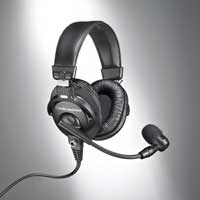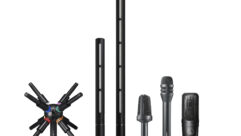

Audio-Technica BPHS1-XF4 Headset
Feb 13, 2012 10:56 AM,
Reviewer: John McJunkin
A sturdy communications headset for many settings.
Communications between professionals during a live production is an important key to success—whether it’s in a theatrical, musical, broadcast, or AV setting. Communication technology has continually advanced over the years, with professionals demanding better products with more features, and the manufacturers meeting those demands. Early headsets for communications were very crude, monophonic, uncomfortable, and did not offer quality audio—inbound or outbound. Manufacturers eventually embraced the notion of comfort, along with sound quality and ultimately stereophonic monitoring for the listener. The refinement continues, and now manufacturers are competing in the domain of price vs. performance. Audio-Technica, one of the major players in this ongoing advancement, has recently introduced its BPHS1-XF4 headset.
My first impression of this headset is that it’s very sturdy. The earpieces are not exactly oval in shape, but more like an Olympic running track—round at top and bottom with straight sides. The drivers are housed in a circular bulge that stands out approximately .5in. I like this relatively low profile; the headset doesn’t add 3in. to either side of the user’s head, a design suitable mostly for bumping into things in crowded control room environments. On either side of these are the pivot points on which the earpiece swivels, attached with metal pins to half-circle-shaped plastic forks that rise up to connect with the headband. The fork on the right side features a red oval-shaped plastic inset to indicate that it is indeed the right channel, and the left features a similar inset of burnished metal. All the plastic parts here strike me as high-quality plastic that can survive substantial impacts. Actually, all the various materials of the components appear to be of hearty quality.
At the top of the plastic forks are links with metal strips that slide inside the headband. These allow for just a tiny bit of swivel in the vertical axis. I would like to see a bit more swivel here, but these are sufficient to maneuver the earpieces into place so that they neatly cover the ear. The headset is intended to reject a substantial amount of ambient noise by virtue of a “circumaural” ear cup that fits snugly but comfortably around the entire ear. The swivel in both vertical and horizontal axes facilitates getting the earcups into place. This ambient noise rejection is not as robust as what you would expect in headsets that are deliberately made for industrial-strength reduction, passive or active, but it truly is sufficient to “seal out crowd noise and other background distractions,” as Audio-Technica’s literature says. The headset’s headband is softly padded and enveloped in a supple leatherette cover. Similarly, the earcups are covered in a soft, pleasant leatherette and padded more generously than the headband, with the obvious goal of comfort and reduced fatigue.
The left side earpiece differs a little from the right, with a circular indentation in which the central pivot of the swiveling mic boom resides. Below this is a squarish protrusion with a downward-facing opening where the headset’s modular cable connects. A knurled thumbscrew secures the cable into this opening. The headset I evaluated shipped with a cable terminated in a 4-pin XLRF-type connector, standard to intercom and inhouse communications. Alternately, a cable terminating in a 3-pin XLR and 1/4in. TRS stereo plug is available, rendering the headset useful for broadcast purposes. The microphone boom is embedded into the left side earpiece and extends in plastic approximately 2in. from the pivot point. Beyond that, an articulated gooseneck metal tube extends the microphone approximately 8in. away from the pivot center. This is a very sturdy gooseneck, clearly intended to survive rough handling and repeated adjustment. In particular, I like that this gooseneck, once it’s adjusted, simply does not waver from where it’s set; it inspires confidence that the mic is not going to stray from where it’s been placed. It can be swiveled around to achieve placement on either the left or right side of the user’s face.
The microphone element itself is attached at the end of the boom with a screw, presumably a removable module that can be replaced if necessary. The mic element is of significant size, approximately 5/8in. in diameter, and 11/2in. in length. It features a very sturdy metal grille, similar to those found on handheld performance mics and approximately 1/2in. in diameter. The phase shift ports that create the mic’s cardioid pickup pattern are metal-screened slots in the sides of the plastic body containing the mic’s element. This is a solid, substantial mic intended to deliver a full, round signal. The dynamic element is based on a neodymium magnet, as are the headset’s two 40mm earpiece drivers, which feature coils of copper-clad aluminum wire. They deliver a frequency response of 20Hz-20kHz, and the microphone delivers a similar response of 40Hz-20kHz. The neodymium magnets render the mic sensitive and capable of delivering good quality transduction. The drivers’ magnets render them capable of handling a lot of power (1.6W, to be exact). This facilitates the delivery of substantial SPL.
I found this headset to be lightweight, which is very important for professionals working on productions of extended duration. A heavy headset becomes oppressive and wears on my neck muscles after some time. The headset is comfortable, with pleasant, soft surfaces anywhere the unit makes contact with my head. The padding goes a long way toward the goal of reducing fatigue, as does the actual designed shape of the earpieces. In terms of sound quality (and quantity), Audio-Technica delivers its usual exceptional standard. Frankly, the earpieces can deliver more SPL than is actually safe for lengthy use, so caution is advised, but better too much than the alternative. And that ample SPL, considered together with the earpieces’ rejection of ambient noise, enables the user to clearly hear cues and/or program signal. The headset’s microphone sounds very good, and its cardioid pattern substantially rejects off-axis sound, giving me a clear voice coming from the other end. I also really like the notion of the modular cable, which makes the headset more versatile, and facilitates easy replacement. Cables are typically the first things to go with a headset of any kind. The exposed wire providing signal to the right earpiece is a minor issue, creating the possibility of damage if the headset is mistreated; however, Audio-Technica has limited this as much as possible by making that wire as short as is practical and situating it to flex in the least harmful way possible.
This is a truly outstanding communications headset, and considering its price, an excellent value as well. I would caution any contractor or producer to avoid the temptation to cut corners on headsets in particular. It’s not worth the potential for missed cues or cranky professionals with stiff necks and fatigued ears. The Audio-Technica BPHS1-XF4 is absolutely worthy of your consideration.
Product Summary
Company:Audio-Technica
Product: BPHS1-XF4 headset
Pros: Sturdy, comfortable, good quality audio in and out.
Cons: Potential damage to exposed wire feeding left earpiece.
Applications: Theater, broadcast, music, and AV production inhouse communication
Price: $279
Specifications
Type: Headphone: closed-back dynamic; microphone: cardioid dynamic
Driver diameter: Headphone: 40mm
Voice coil: Copper-clad aluminum wire
Frequency response: Headphone: 20-20,000Hz; microphone: 40-20,000Hz
Maximum input power: 1,600 mW @ 1kHz
Sensitivity: Headphone: 100dB; microphone: -57dB (1.4 mV) ref 1V at 1 Pa
Impedance: Headphone: 65Ω; microphone 560Ω
Weight: 264 grams (9.3oz)
Dimensions: Earcup 82.0mm (3.23in.) wide; headband: 46.0mm (1.81in.) wide; boom: 180.1mm (7.09in.) long, microphone extended; mic: 24.0mm (0.94in.) diameter
Cable: 2 meters (6.6ft.) long with 8-pin connector at headset end; 4-pin XLRF-type connector output
John McJunkin is the principal of Avalon Podcasting in Chandler, Ariz. He has consulted in the development of studios and installations and provides high-quality podcast-production services.









